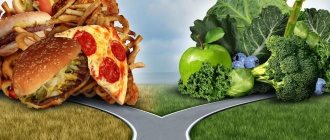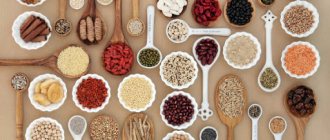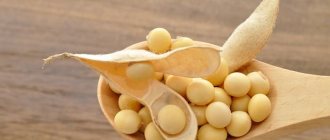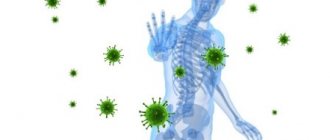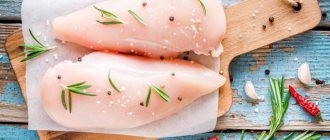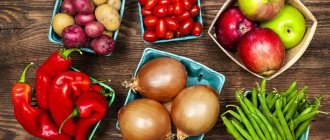Full text of the article:
If earlier vegetarianism was a rarity, and vegetarians could rarely be found in company, now vegetarianism will not surprise anyone. The menus of many restaurants and cafes now have separate sections for vegetarians, and more and more recipes for vegetarian food can be found on the Internet.
Vegetarianism
can be considered a certain cultural phenomenon, and if you try to study it in more detail, you will find that vegetarianism can have various reasons. Some people have to give up animal products for medical reasons, while others do it out of moral convictions. Be that as it may, a person who decides to become a vegetarian must understand what proper nutrition for vegetarians should be, otherwise such a “diet” can be very stressful for the body.
Vegetarian and vegan menu
“Being vegetarian” can be done in different ways. First, it’s worth distinguishing between vegetarians
and
vegans
, these two similar words can be the key to answering the question: “How to feed a vegan?”
Vegetarians, unlike vegans, have a more varied diet. They can eat eggs, honey, dairy products
, and some do not refuse
fish
. Vegans do not accept foods that come from animals, so do not try to offer dairy products or foods made with milk or eggs to a vegan. Vegans will refuse both fish and even honey.
If a person decides to become a vegan in adulthood, and before that he calmly consumed animal products, then this is fraught with negative consequences for the entire body. Excluding animal products from the diet without equivalent “compensation” will lead to a sharp deficiency of many nutrients, vitamins and minerals that are necessary for the proper functioning of the body.
Plant-protein diet
This method of losing weight allows you to get rid of most of the fat deposits, because the method is very similar to “drying”. The duration is short - 10 days, but during this period you can safely say goodbye to 5-6 kilograms. A plant-protein diet requires discipline and strict adherence to a given schedule. Eating food should correspond to a built-in system: on certain days you need to eat only the specified foods.
Plant-protein diet menu:
Day No. 1, 2, 7: the menu should consist exclusively of kefir. The total volume per day is 1.5 liters.
Day No. 3, 6, 8: eating protein foods - low-fat dairy products, boiled or steamed meat, fish, meat broths, eggs.
Day No. 4, 5, 9, 10: vegetarian products - fresh vegetables, fruits, steamed food, smoothies, freshly squeezed juices, salads with lemon juice dressing are allowed.
The first days it is difficult to adhere to this scheme, but already on the third day the body will adapt, and a feeling of lightness and satiety will appear. Do not forget about drinking herbal teas, and it is better to refrain from coffee.
It is not recommended to follow any diets during pregnancy, but sometimes it is simply necessary. For pregnant women, the regimen should be prescribed by a nutritionist so as not to harm the unborn child and the mother herself, because the immune system during this period is already weakened.
Pregnant women exclude from the diet all sweets, flour, fried, smoked, salty, as well as grapes, melon, bananas, and sweet varieties of apples. Portions should be small, high in protein and fiber to provide a basic calorie intake. While losing weight, the expectant mother should be under the supervision of doctors. The course of the program is 8 days.
Sample menu:
Day No. 1, 2: low-fat steamed fish and meat, clean water, green tea.
Day No. 3, 4: stewed, boiled and fresh vegetables, unsweetened fruits.
Days No. 5, 6: days number one and two are repeated.
Days 7 and 8: Days three and four are repeated.
What should be the proper diet for vegans and vegetarians?
Doctors recommend switching to a vegan diet exclusively for adults. This decision should be balanced, and the transition itself should take place gradually
.
It is better to first contact a specialist
who will help you create the right diet based on the current needs of the body. The doctor will conduct an examination, may prescribe a number of examinations, ask questions and tell you about possible contraindications and health risks. The doctor can also tell you which plant products can fully replace animals.
It is better to make the transition to a plant-based diet flexible
. The diet should not be reduced, but changed. If you remove an animal product from the menu, it should be replaced by one or more plant products. For example, meat is usually replaced with legumes, but the body must get used to such a replacement gradually so that the person does not get an upset stomach as a result.
The basis of a healthy nutrition menu for vegans should be cereals, vegetables and fruits,
as well as
bread
and
nuts
.
If a person has previously adhered to the principles of a healthy diet, then such a diet should be familiar to him, because a healthy diet is based on plant products, not animal products, their share should be about 75% versus 25%. However, animal products provide the body with a lot of protein
.
To maintain balance, it will be necessary to form the protein part of the diet by adding legumes, nuts, mushrooms
and
soy products
.
They should be present in every meal and make up at least half of the serving.
A whole plant-based diet is a vegetarian's dream!
This nutritional plan is based on minimally processed foods. In this case, any sources of animal protein must be excluded: milk, cheese, eggs, meat, fish, yogurt, seafood, etc. With a whole plant-based diet, a complete abstinence from sugar, salt and fat will be required for the entire period.
recipes include:
- various salads with citrus dressing;
- fresh fruit and vegetable juices;
- steam cutlets;
- stew of stewed vegetables;
- vegetable soups and much more.
Deficiency of vitamins and substances
Veganism may not be beneficial if you treat it like a fashion and do not consciously change your diet. If you suddenly give up your usual foods and rely on “bread and water,” your body can quickly develop a deficiency
various vitamins and minerals. Some deficiencies can go almost unnoticed, while others can be dangerous, especially when it comes to children and pregnant and lactating women.
The body may experience a lack of protein, calcium, iodine, iron, zinc
and a number of vitamins, the suppliers of which are mainly animal products. Let's look at what various deficiencies can lead to.
Protein deficiency
Protein
- this is the main “building material” of the body; it is necessary for a person to
grow and develop
.
If the body does not receive enough protein from food, the body begins to use the accumulated protein, taking it from muscle tissue. muscle mass
noticeably , and then
a loss of strength
.
A dangerous consequence of protein deficiency can be organ prolapse
due to a decrease in the muscle that fixes it.
To make up for protein deficiency with plant foods, you need to eat more legumes, grains, soy products, as well as mushrooms, seeds and nuts.
Calcium deficiency
Calcium
- This is the basis of
bones, joints
and the entire
musculoskeletal system
.
Calcium is also found in teeth and hair and is essential for maintaining overall skin tone. The main food supplier of calcium is dairy products. If you exclude them from the diet, then you need to add nuts, kale
and
broccoli
,
spinach, sesame seeds, parsley
and
sunflower seeds
.
You can find foods artificially fortified with calcium, such as tofu
and some types
of juices
.
Iodine deficiency
Iodine
necessary for proper functioning
of the thyroid gland
, the easiest way to get iodine is from
seafood
.
Unfortunately, most of the territory of our country is remote from the sea, so residents cannot consume enough seafood and satisfy the body’s needs for iodine, which leads to various diseases of the thyroid gland
and metabolic disorders.
The best plant source of iodine is seaweed
; iodine is also found in
buckwheat
and
millet
. To prevent iodine deficiency, you can use iodized salt for cooking.
Iron deficiency
Iron
plays an important role in organizing the process of saturating the body
with oxygen
.
Animal products contain sufficient amounts of iron, and vegans need to take care not to become deficient. The fact is that in plant foods the iron content is lower, in addition, “plant iron” is less absorbed, and dietary fiber removes metals from the body, so there is a high probability that iron will be excreted from the body in larger volumes than it is supplied. Among plant foods, the highest iron content can be found in porcini mushrooms, parsley, mustard and sesame seeds, peaches, apricots and spinach
. You also need to take into account that iron is absorbed only together with protein and vitamin C.
Zinc deficiency
Zinc deficiency is not so obvious, but zinc
is part of many
enzymes
and supports the functioning
of the human immune system
. Wheat sprouts, pumpkin and sunflower seeds, carrots, sweet peppers, white cabbage, eggplants, onions, garlic, oatmeal, soy products, lentils and other foods are rich in zinc.
Vitamin B12 deficiency
Vitamin B12 deficiency
Vegans have the hardest time replenishing because this vitamin is
only found in animal products
and it is simply impossible to find an alternative in plant foods.
Meanwhile, vitamin B12 deficiency can lead to anemia
. Red blood cells in the body are destroyed prematurely, so organs and tissues are not sufficiently supplied with oxygen. Doctors recommend that vegans look for foods artificially fortified with vitamin B12 or use dietary supplements.
Vitamin D deficiency
Vitamin D
The body is capable of producing it on its own; this happens when the skin is exposed to
sunlight
.
However, during periods when there is not enough sun, it is necessary to replenish the vitamin D deficiency through food. Vitamin D content in plant foods is much lower than in animal foods, however, vitamin D can be obtained from some mushrooms (morels, chanterelles, shiitakes)
, as well as from foods that are specially fortified with vitamin D.
Omega-3 fatty acid deficiency
Replenish the deficiency of Omega-3 fatty acids
It's easiest for vegans because they are found in both animal and plant foods.
Omega-3 fatty acids are needed by the body to regulate metabolic processes
and the proper functioning
of the cardiovascular system
.
You can get them from nuts, tofu and various oils: flaxseed, rapeseed and soybean.
Reducing the risks of heart attack and stroke
Nowadays in Europe and the USA, vegetable analogues of butter - spreads - are popular.
They are produced from a composition of vegetable oils: olive, soybean, corn, palm, rapeseed. They contain a lot of healthy fats - omega-3, 6 and 9, which protect the heart and blood vessels. Such products are also appearing in Russia. For example, the Federal Research Center for Nutrition and Biotechnology recently completed clinical studies of a vegetable-fat spread with a mass fraction of fat of 50% and the addition of phytosterols and vitamin E. The product was developed by employees as part of a comprehensive scientific research plan. They were studying whether it could improve the condition of patients with dyslipidemia, a set of problems in the body in which the normal ratio of lipids (fats) in the blood is disrupted. This condition can increase the risk of heart attack and stroke.
The patients were divided into two groups, which were completely comparable based on gender, age, body weight and health status.
The first group ate a specially low-calorie diet for 20 days. The second part of the subjects, in addition to the same diet, received a jar of vegetable spread every day in the amount of 30 g per day. A comparative analysis of diets showed that including the spread in the diet helped reduce total cholesterol by 17% and “bad” cholesterol (LDL) by 26%, which allows it to be recommended as a product with beneficial health effects.
What do vegans need to consider?
Adjusting the diet cannot always fully provide the body with the necessary vitamins and microelements, so people, especially vegetarians, in some cases need to take vitamin and mineral complexes
.
This is especially important for women to do during pregnancy and breastfeeding
.
With age, some vitamins begin to be less readily absorbed by the body, for example, vitamin D. It is especially important to monitor its content for people over 35 years of age
.
Only people who do not have relevant contraindications
.
For example, if a person has problems with the functioning of the gallbladder
and
the outflow of bile
, then refusing to consume saturated animal fats can lead to an overflow of the gallbladder and, as a result, to pain and stool disorders. This is just one example of why you need to prepare for a radical change in diet in advance, taking into account the possible consequences.
When preparing a diet, it is necessary to take into account the climatic conditions of your residence.
.
Western experience cannot always be fully projected onto Russian realities, so if you decide to adopt the experience of vegetarianism and veganism from people more experienced in this matter, it is better to choose one of your compatriots, or even better to focus on someone who lives in the same region. Although it is worth adopting only individual tips, since it is better to entrust the preparation of a diet to a nutritionist
. Only a qualified doctor can think through a diet that will meet the individual characteristics and needs of your body and will not harm your health.
Sample menu for the week
When switching to whole foods, your diet doesn't have to be complicated.
The following one-week menu will help you get your bearings. It does include small amounts of animal products, but the extent to which you include animal products in your diet depends on your preferences and goals.
Monday
Breakfast : Oatmeal with coconut milk, berries and walnuts.
Lunch : Large salad of fresh vegetables, chickpeas, avocado, pumpkin seeds and goat cheese.
Dinner : pumpkin curry.
Tuesday
Breakfast : Plain (non-fat) yogurt with sliced strawberries, unsweetened coconut and pumpkin seeds.
Lunch : chili without meat.
Dinner : Boiled sweet potatoes and black beans.
Wednesday
Breakfast : coconut milk smoothie with berries, peanut butter.
Lunch : hummus and fresh or boiled vegetables.
Dinner : Zucchini noodles with pesto and chicken meatballs.
Thursday
Breakfast : Oatmeal with avocado, salsa and black beans.
Lunch : quinoa with feta cheese.
Dinner : Grilled fish with roasted sweet potatoes and broccoli.
Friday
Breakfast : Tofu and frittata with vegetables.
Lunch : large vegetable salad with grilled shrimp.
Dinner : Roasted bell peppers with brown rice.
Saturday
Breakfast : Coconut milk smoothie with blackberries and cashews.
Lunch : Avocado and brown rice sushi with seaweed salad.
Dinner : Eggplant lasagna with cheese and a large green salad.
Sunday
Breakfast : vegetable omelet with eggs.
Lunch : stewed vegetables with bulgur.
Dinner : large salad of vegetables and avocado.
As you can see, a plant-based diet is all about consuming animal products in moderation.
However, many people following this diet consume more or less animal products depending on their specific dietary needs and preferences.
You can enjoy a variety of delicious foods while following a plant-based diet. Our suggested menu for the week will help you get started.
Leafy vegetables
Leafy vegetables include spinach, rhubarb, nettle, sorrel, quinoa, a variety of green salads (lettuce, green salad, etc.), as well as those used in the form of spicy seasonings: parsley, dill, mint, thyme, thyme, tarragon, bay leaf, etc. Leafy vegetables contain a large amount of water (about 90%), valuable and easily digestible proteins, although in small quantities, and the green coloring matter chlorophyll, which plays an important role in the process of hematopoiesis in the body. In addition, these vegetables are rich in vitamin C and carotene (a substance that turns into vitamin A in the body) and contain large quantities of valuable minerals. A wide variety of snacks and soups, salads and side dishes are prepared from them. They can be combined very well with meat - young lamb and veal. With age, the amount of indigestible cellulose in plants increases, and the amount of proteins and carbohydrates decreases. Therefore, young and fresh leafy vegetables are more valuable.
Pumpkin seeds
They contain a lot of zinc, which is needed for the absorption of vitamin D, cell renewal and, most importantly, the synthesis of leukocytes, cells of the immune system, which are the first to defend the body from foreign invasions, pathogenic viruses and bacteria.
100 grams of pumpkin seeds contain 7.4 mg of zinc, which is about half the daily value. They also contain healthy fatty acids and vitamins that improve the condition of hair and skin. In addition, pumpkin seeds are valued for their antiparasitic and anti-inflammatory properties. In addition to zinc, they contain vitamins B, E, K, C, as well as sodium, potassium, calcium, manganese, magnesium and phosphorus. Keep in mind that it is raw, not roasted, pumpkin seeds that are most beneficial.
Is it good to crack seeds? Unexpected properties of the usual “entertainment” Read more
Nuts
These include walnuts, hazelnuts, almonds, peanuts, chestnuts, etc. Of all plant foods, they contain the least amount of water, a significant amount of proteins and carbohydrates, and a lot of fat. Only chestnuts contain little fat and a lot of carbohydrates. The fats of nut varieties are primarily liquid oils that are obtained by pressing nut kernels and are food products. They contain a significant amount of salts, vitamin BI and carotene, and peanuts contain a lot of vitamin E.
Nuts are consumed raw or roasted. A subgroup of nuts are the seeds of various spices: black pepper, cumin, coriander, allspice, mustard, anise, sesame and nutmeg. These spices contain valuable aromatic and flavoring substances. Used only as spices.


